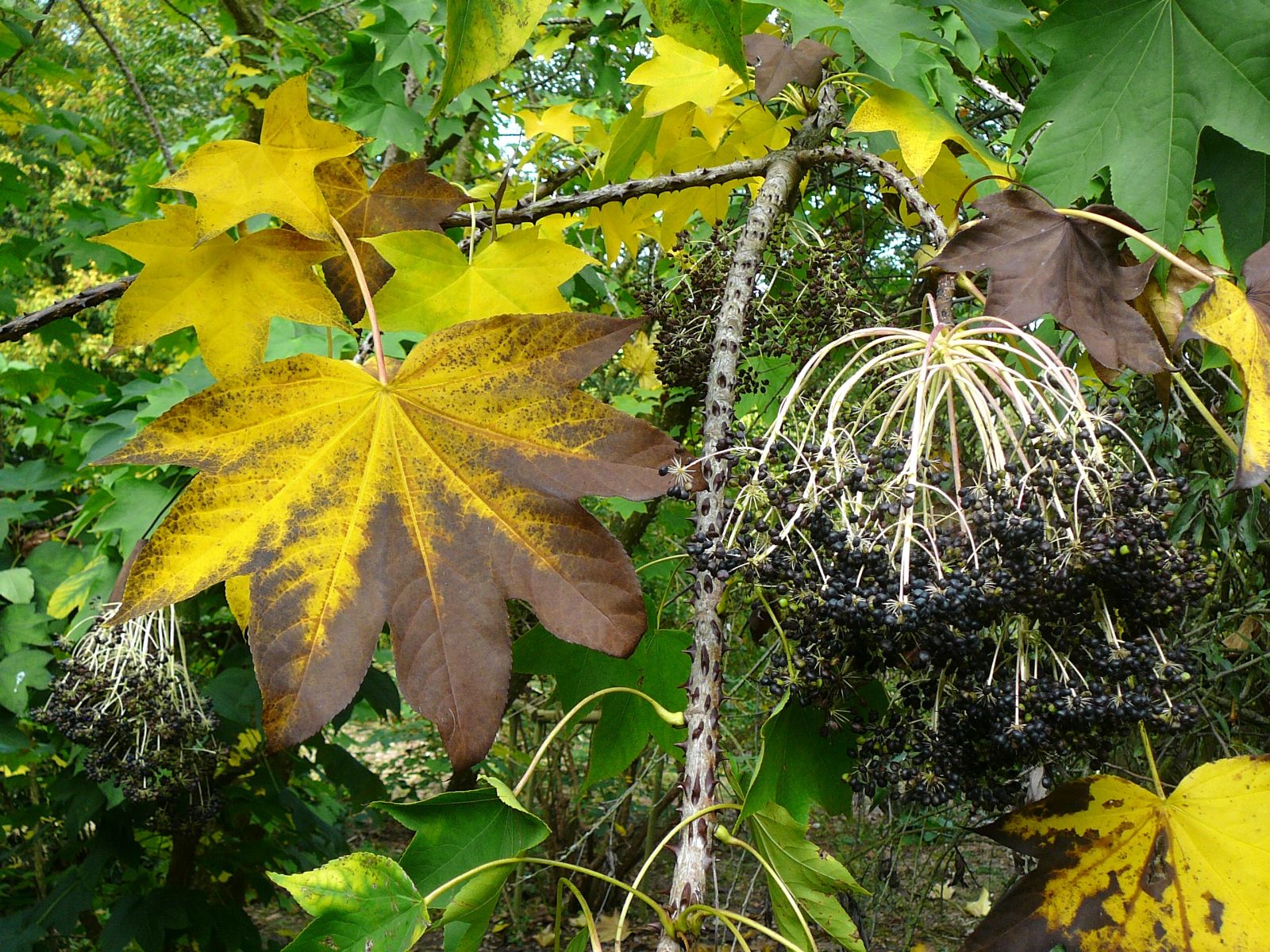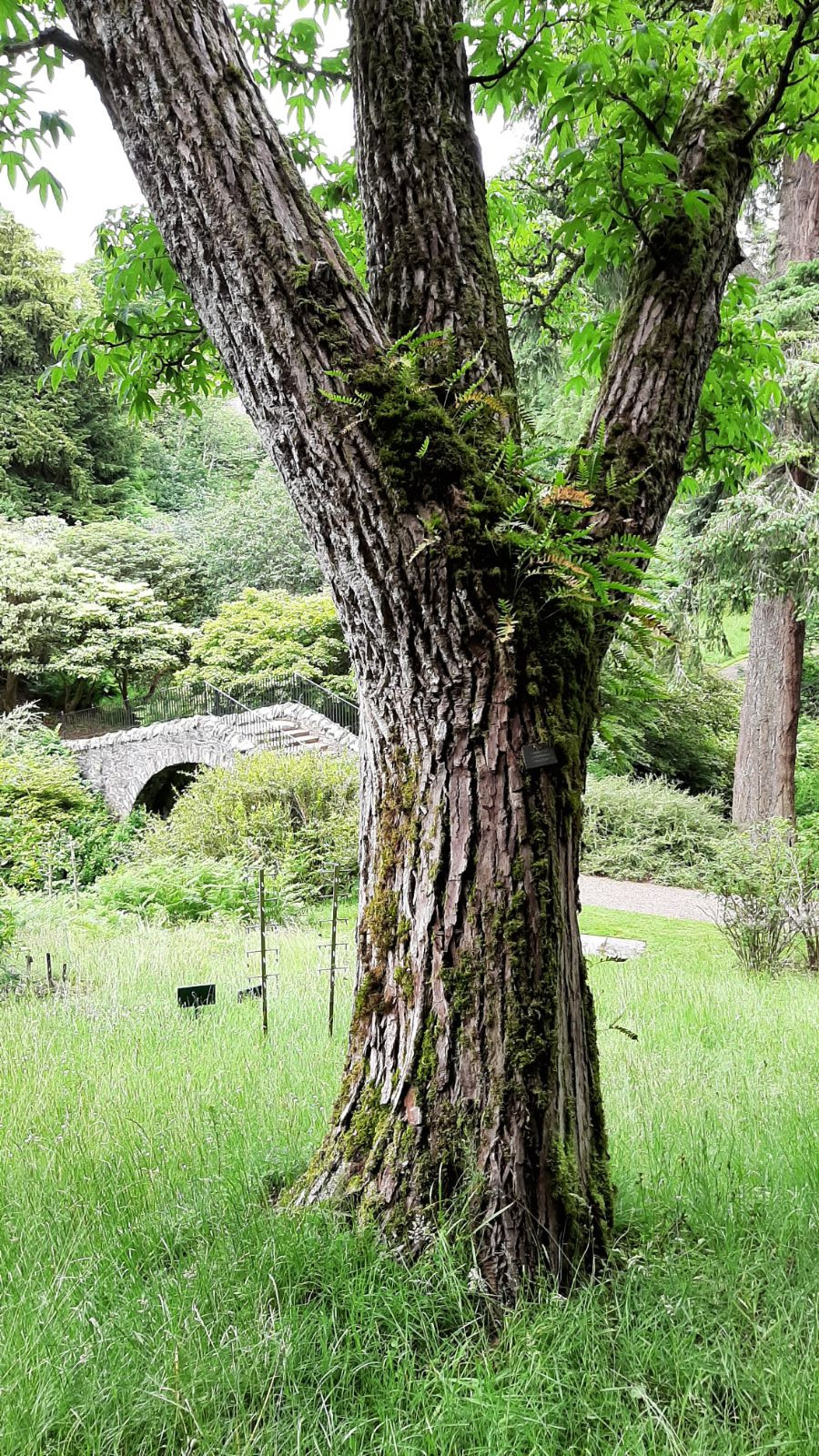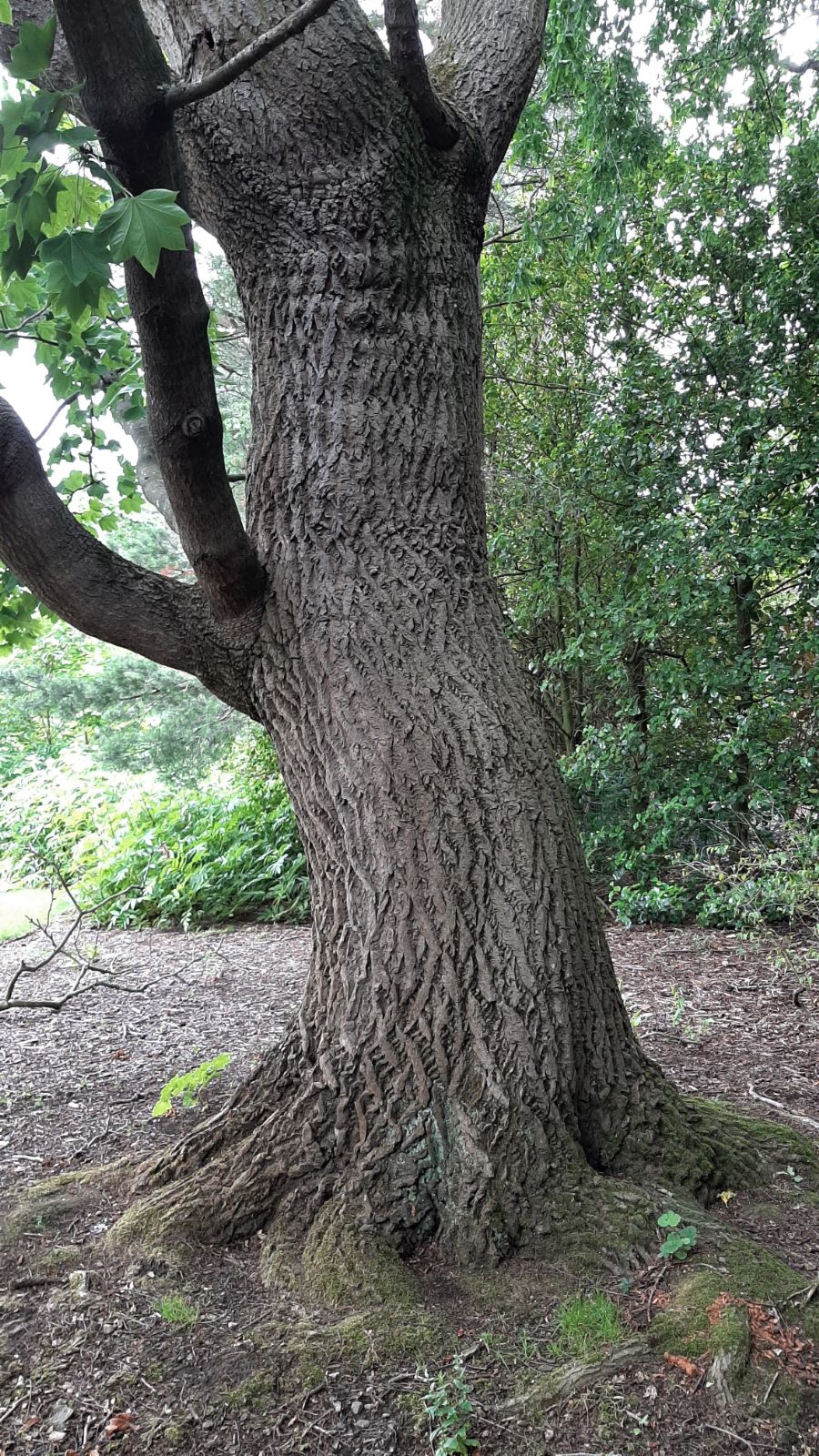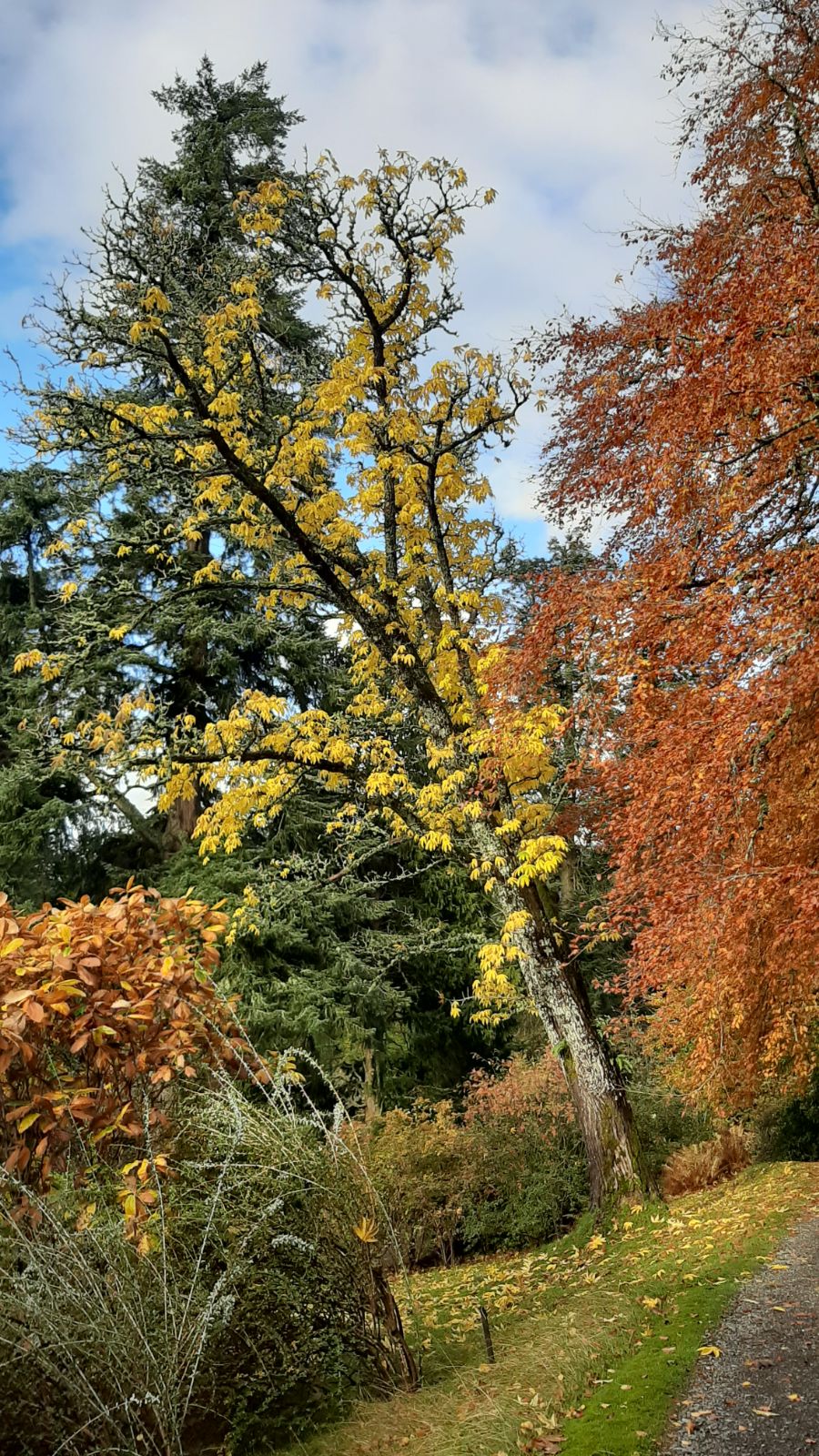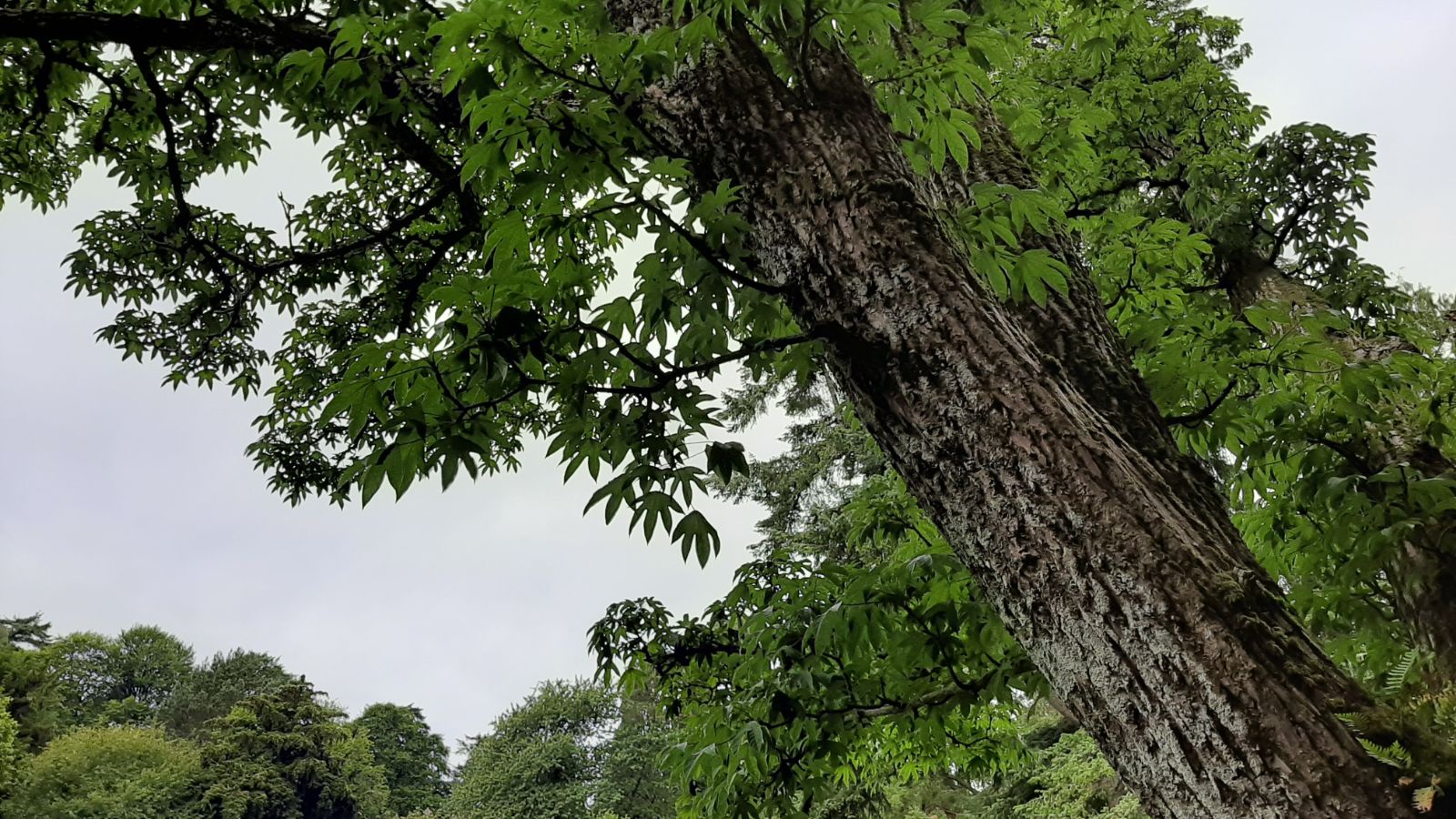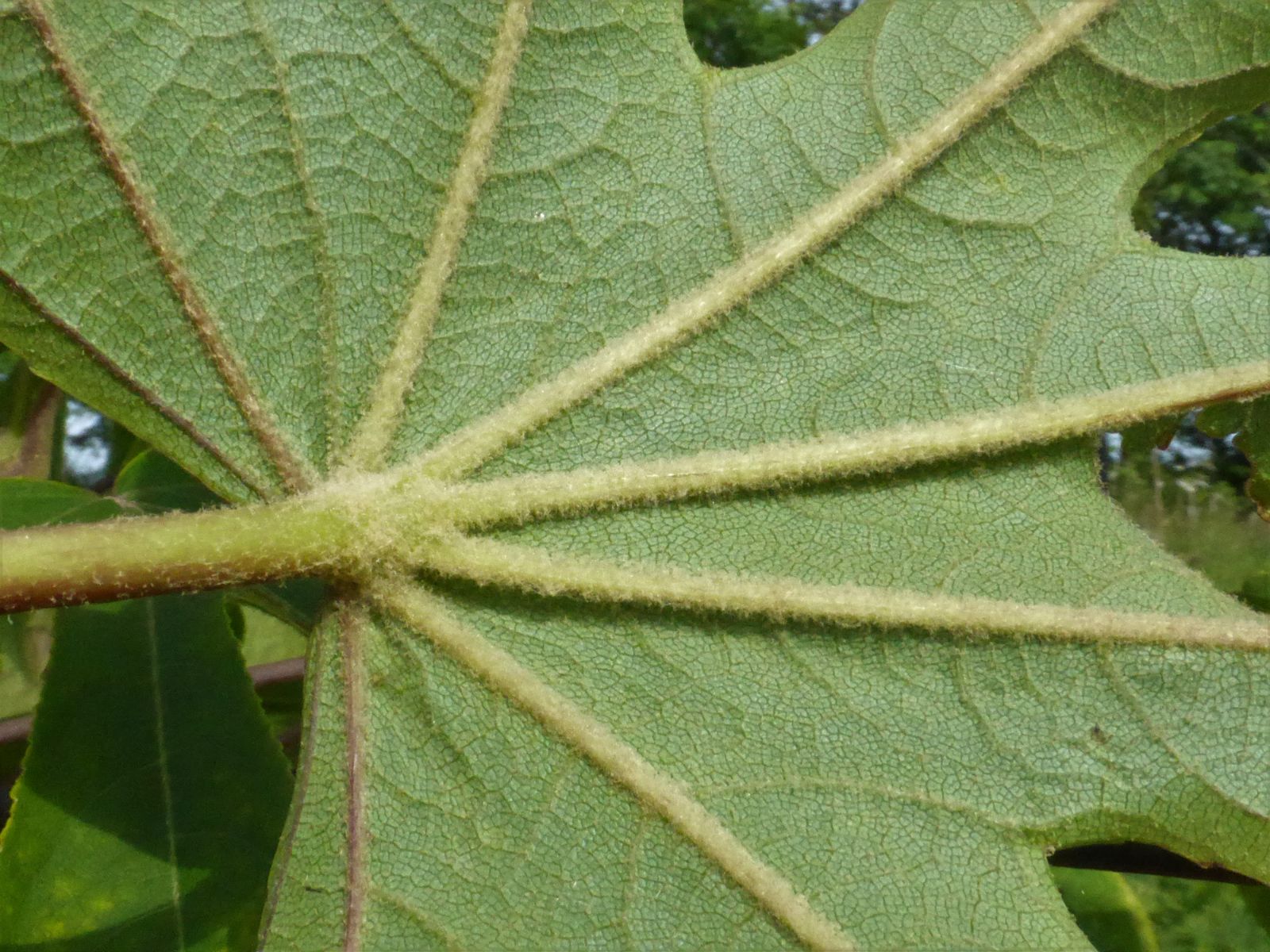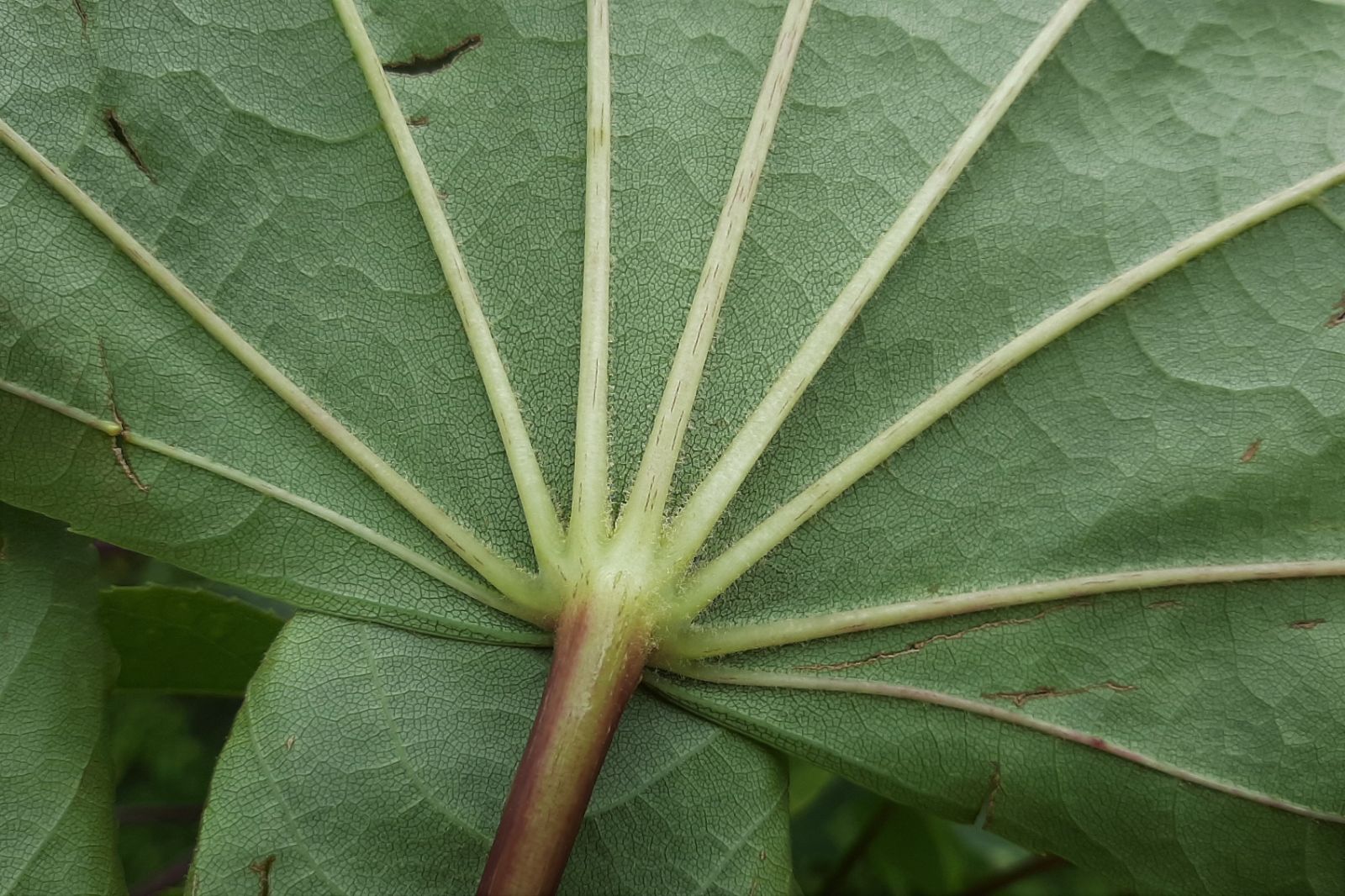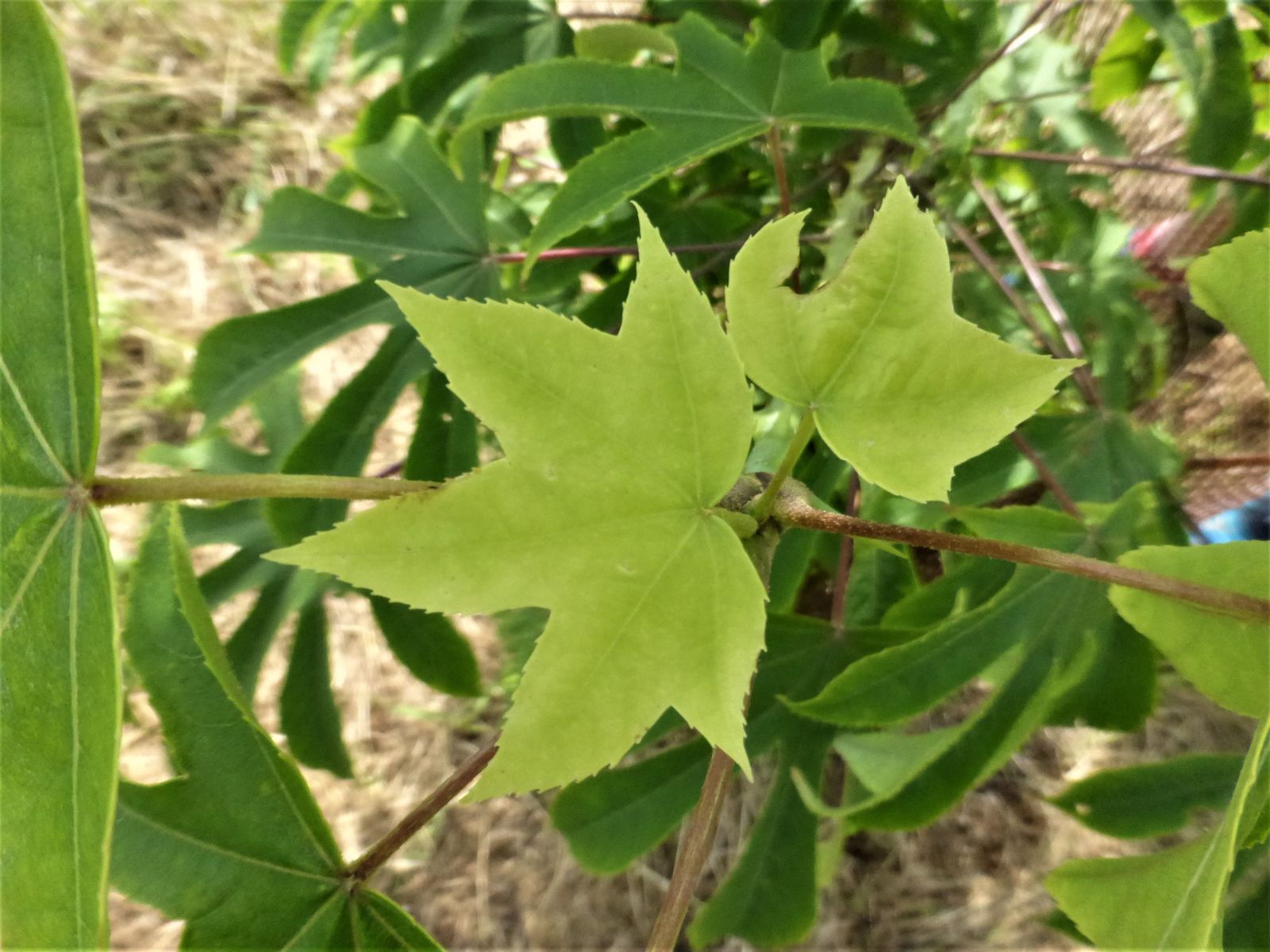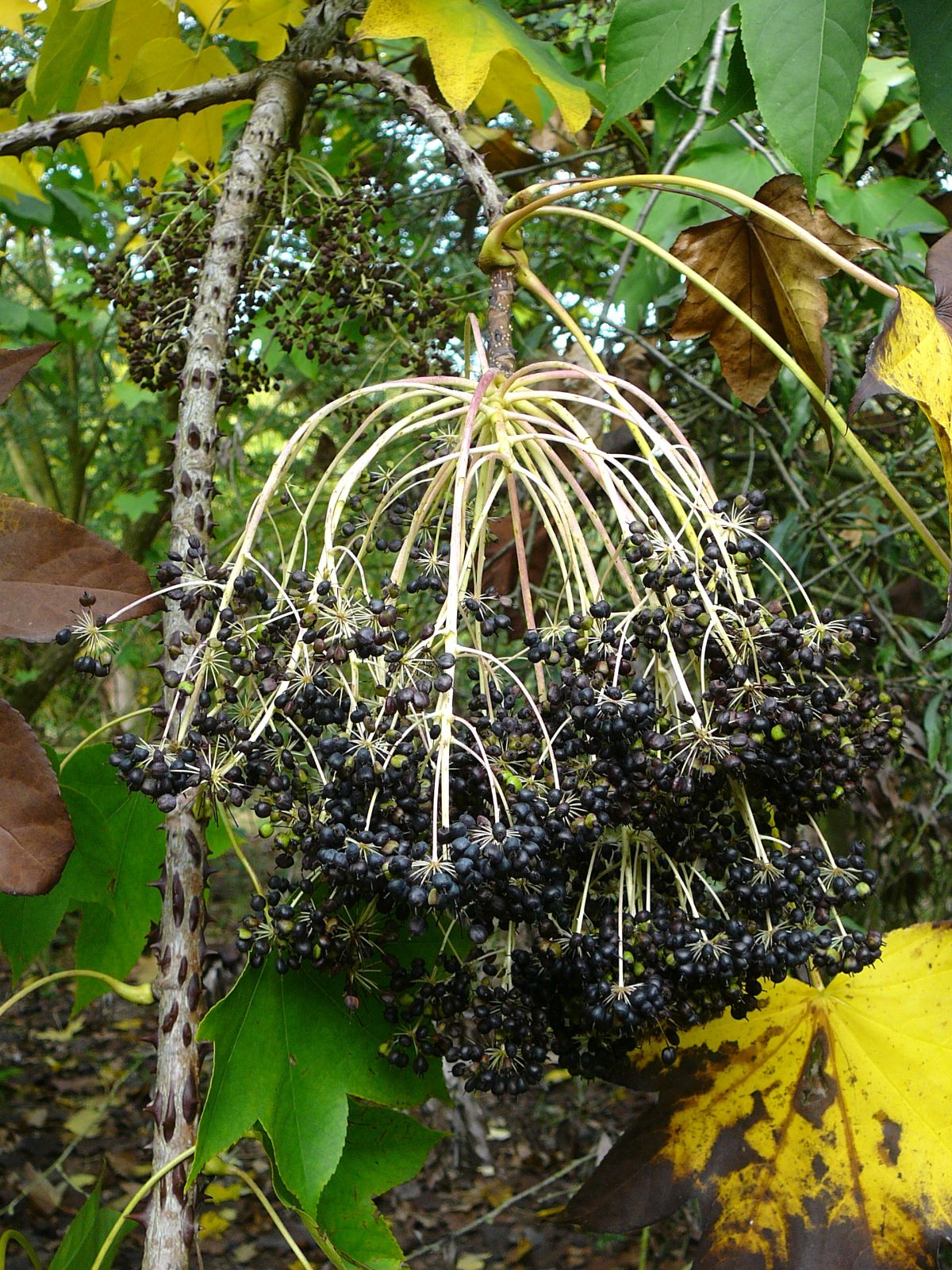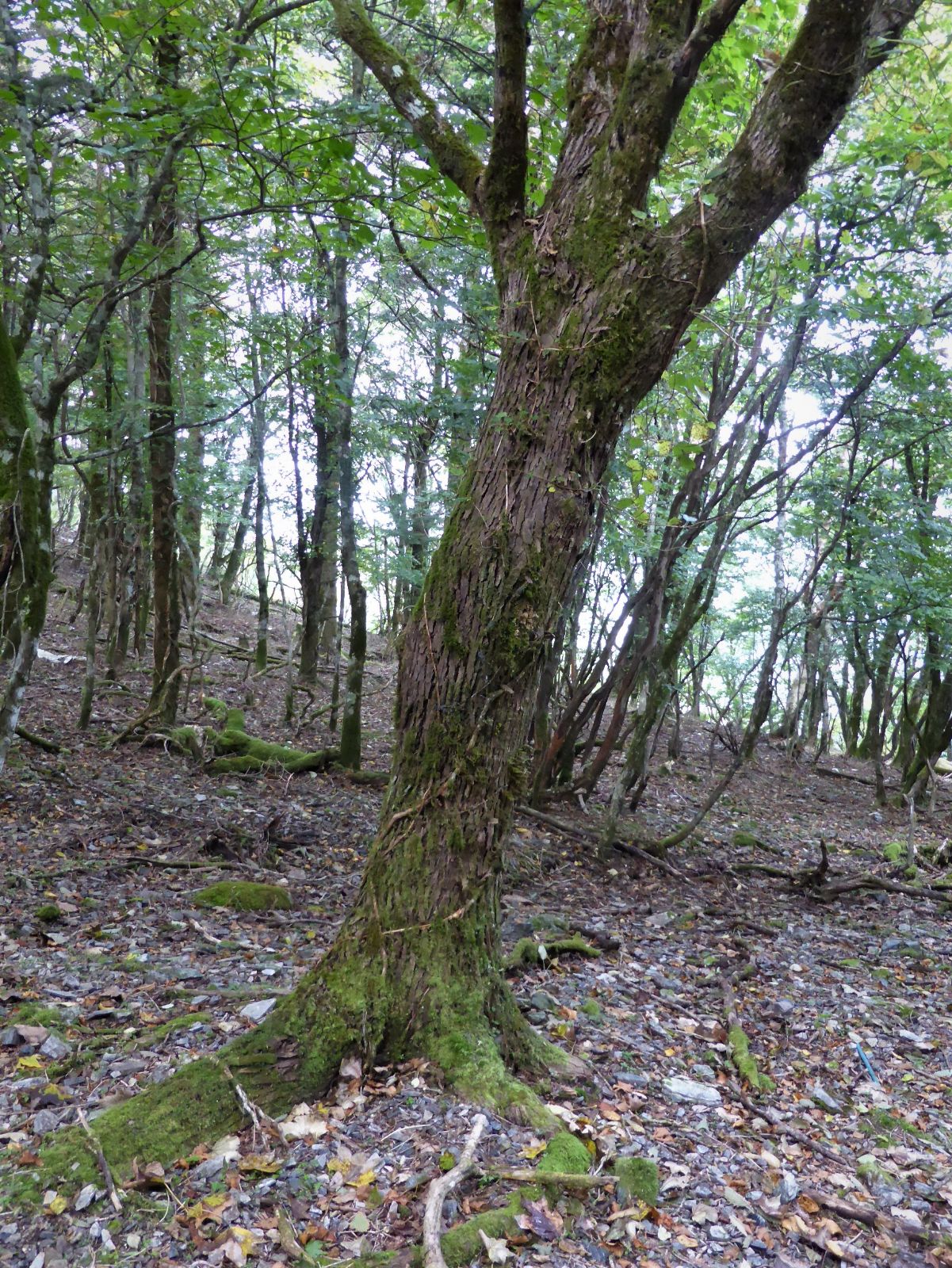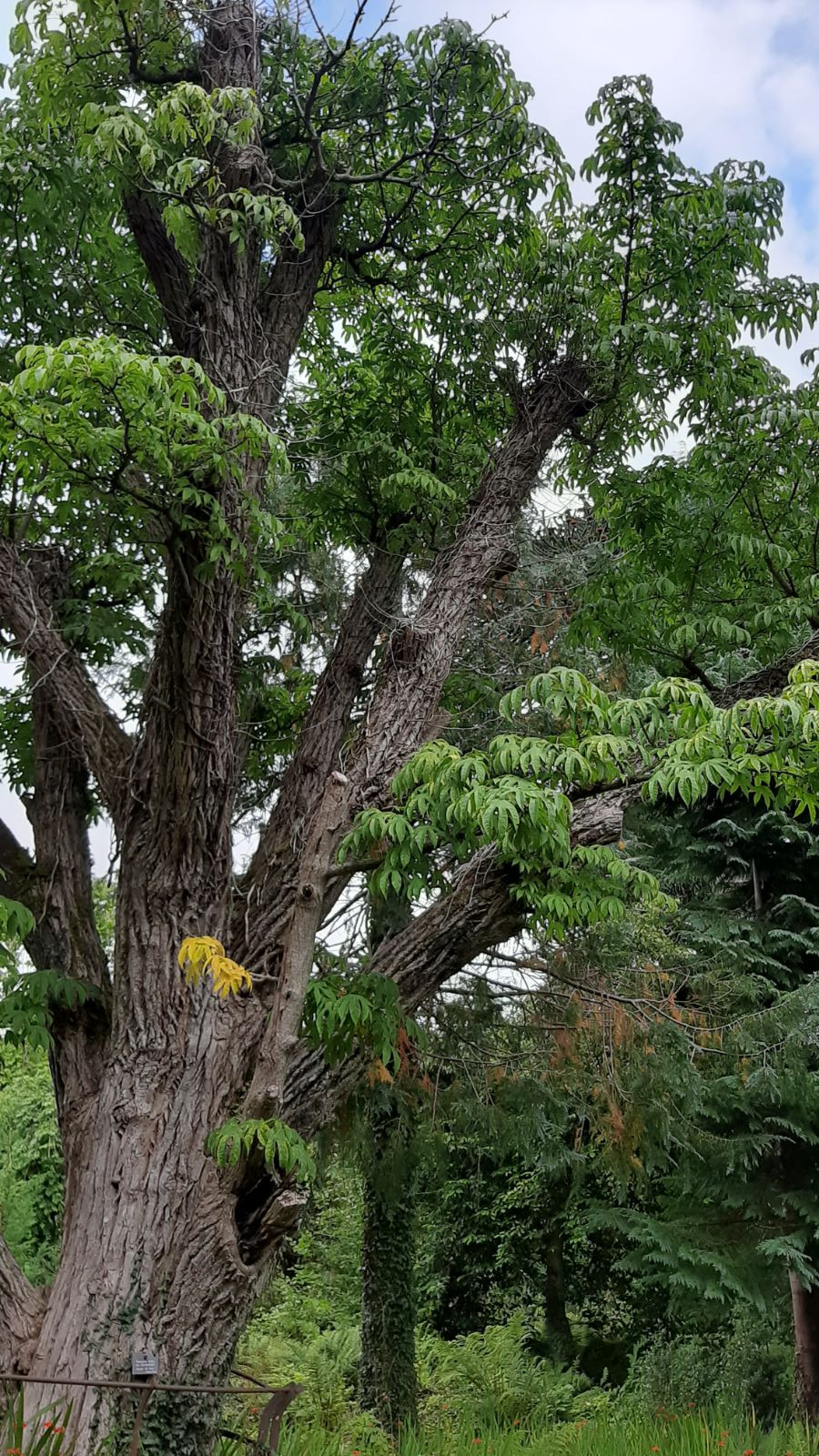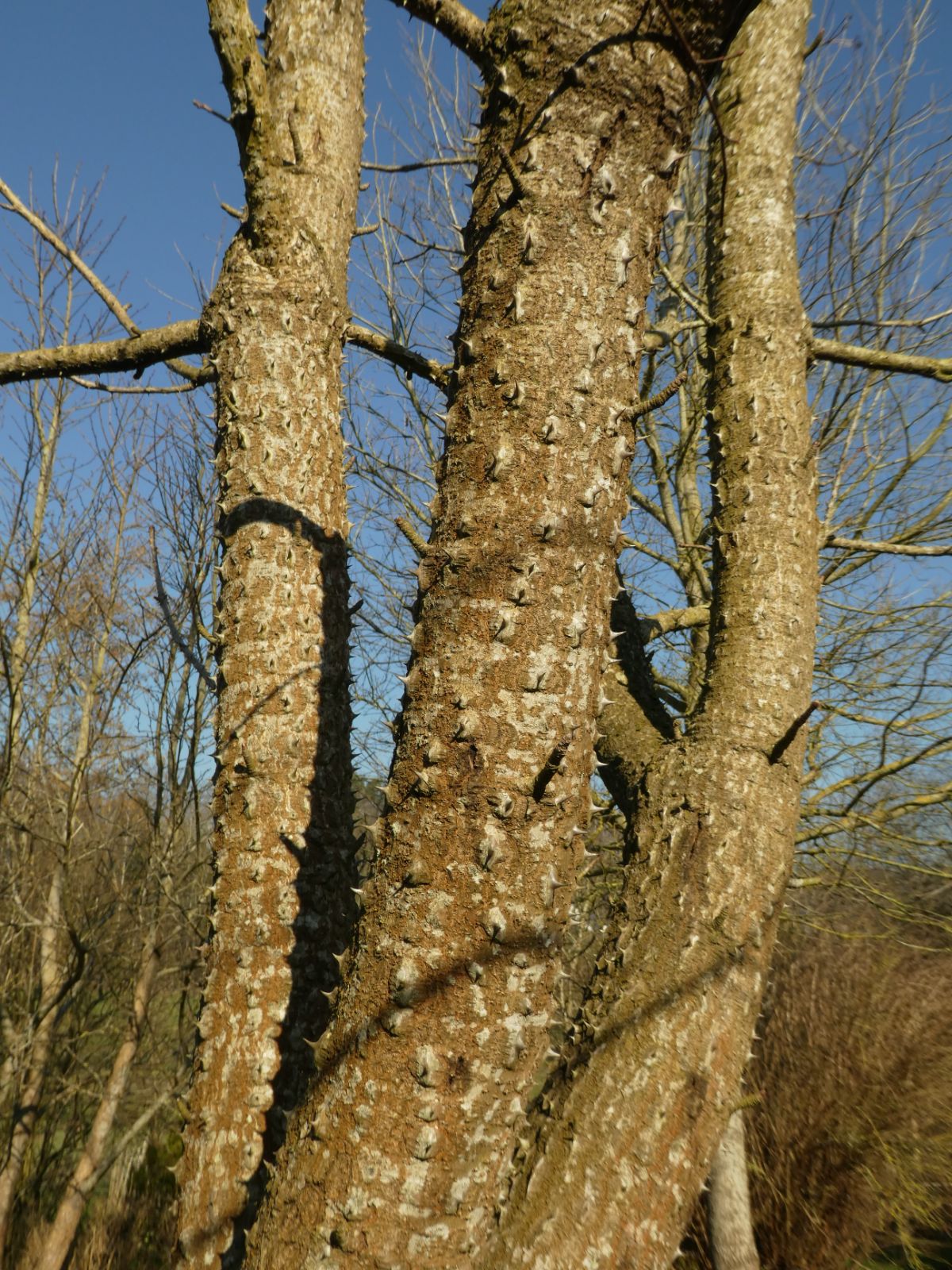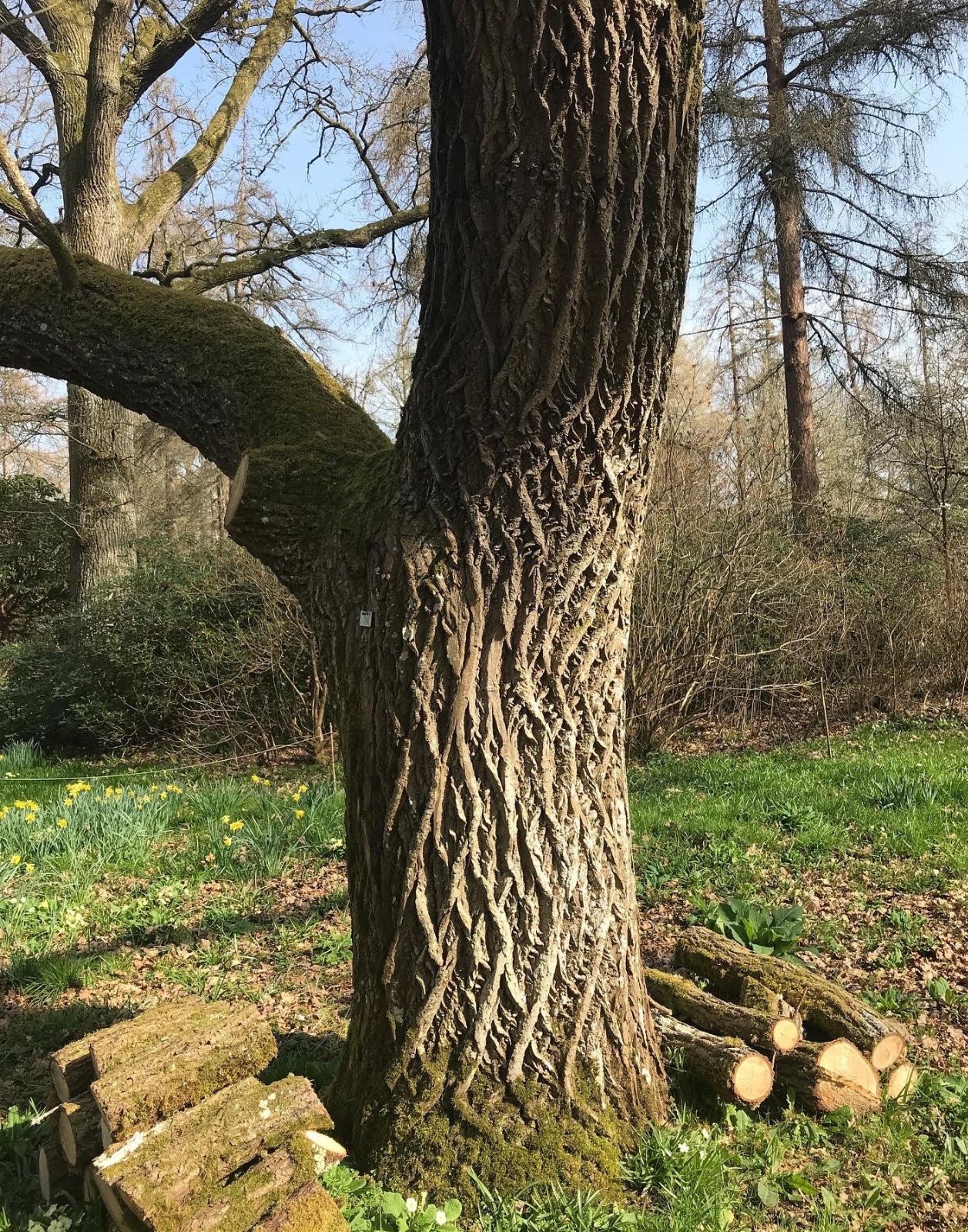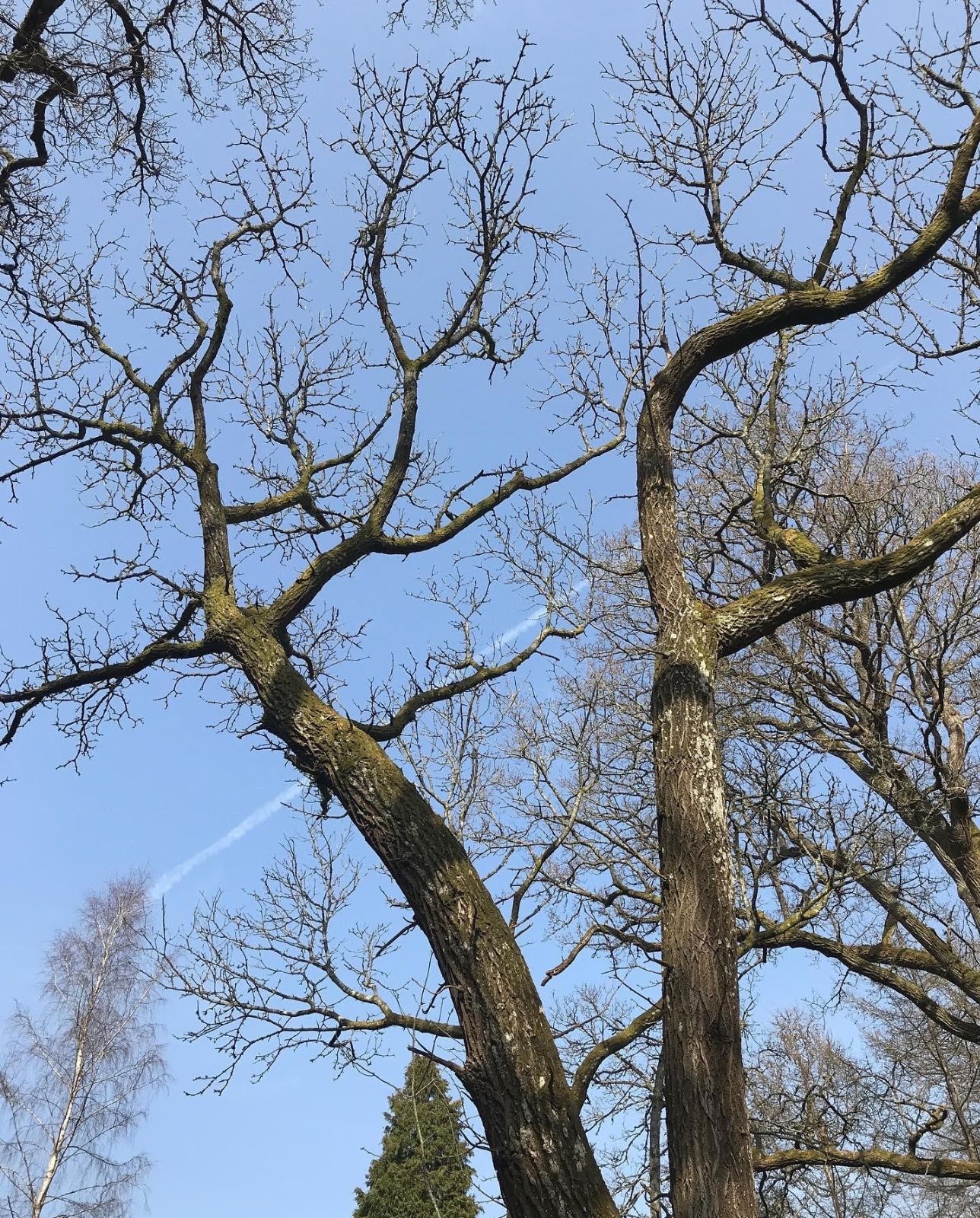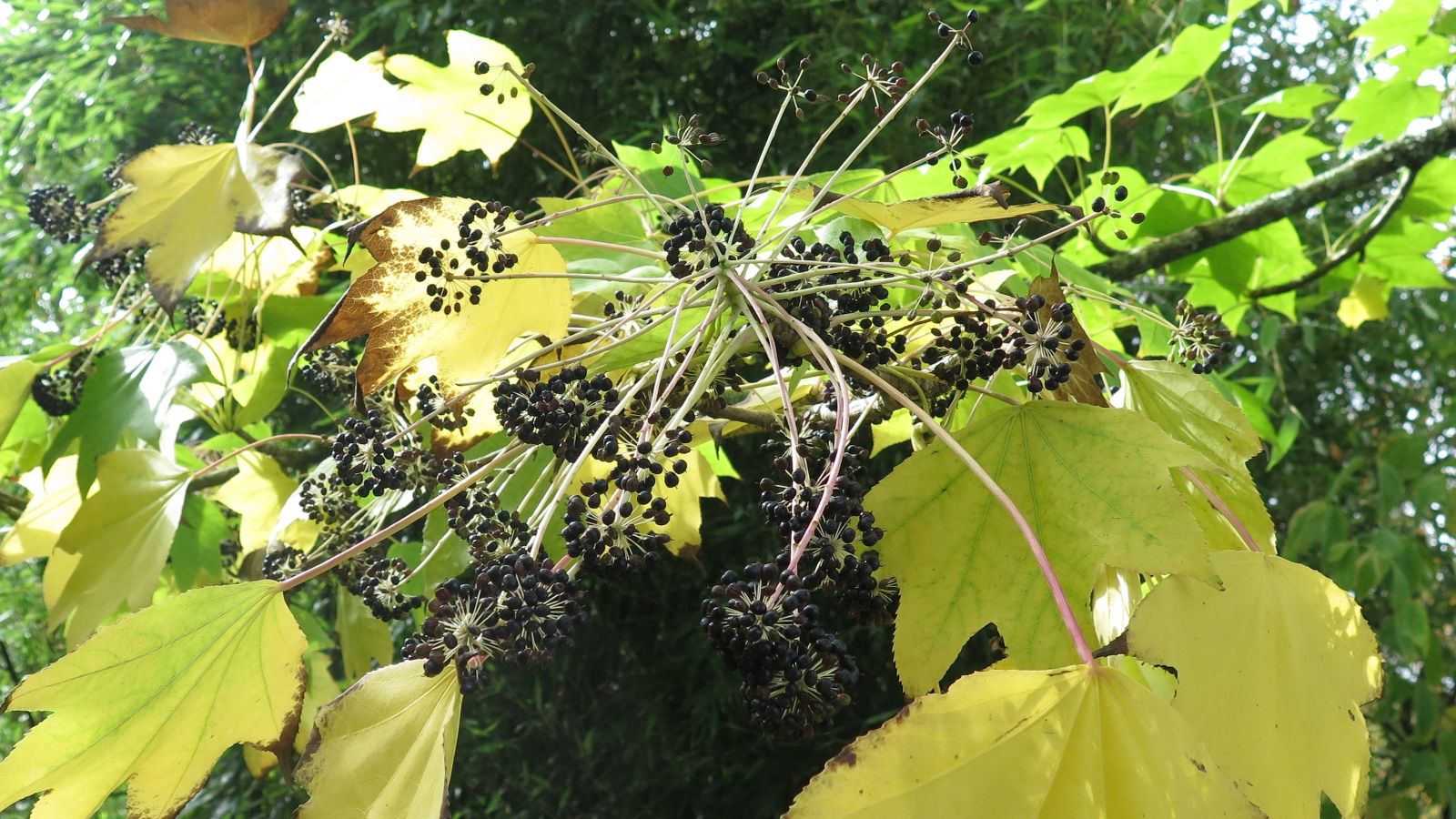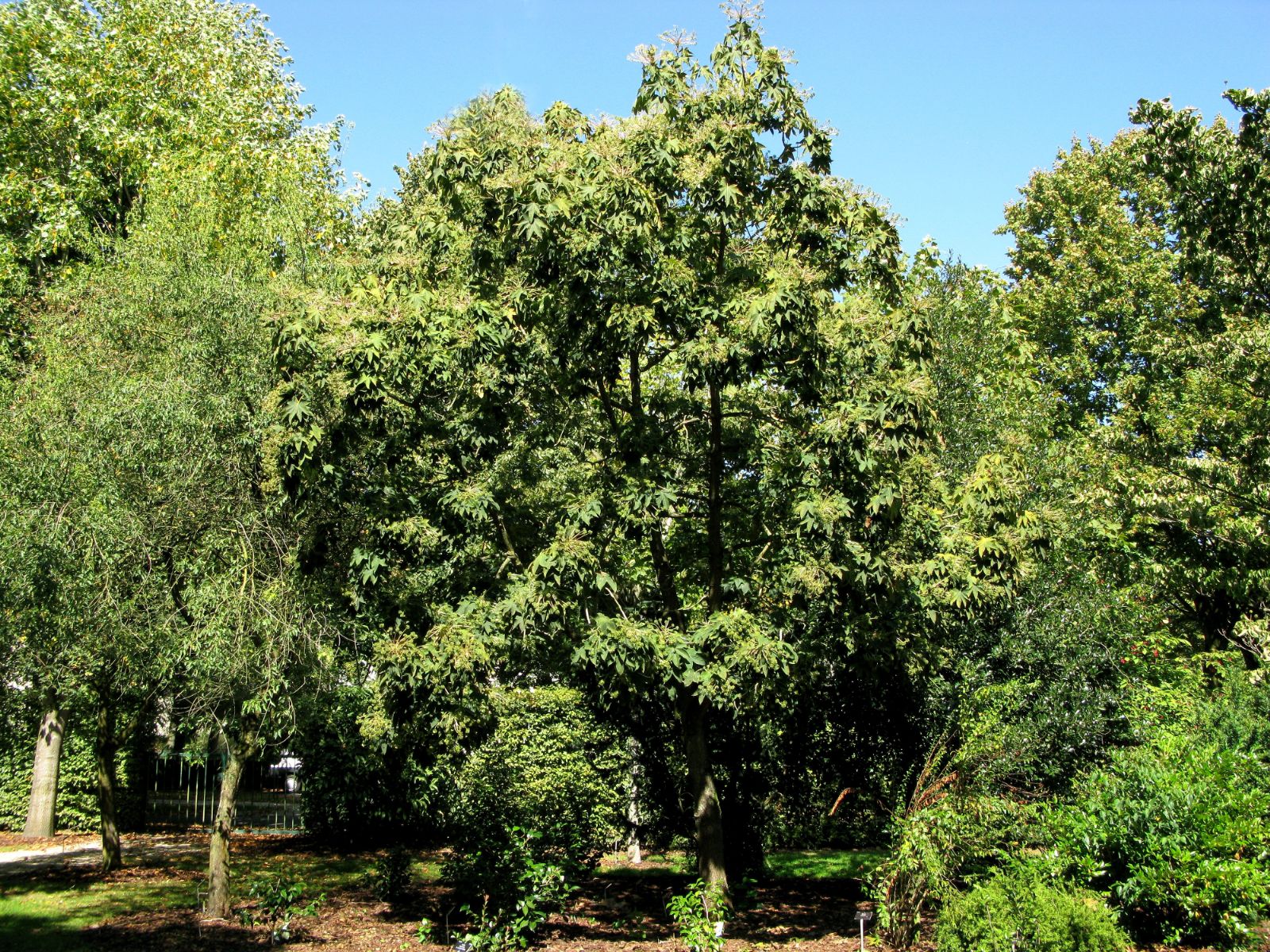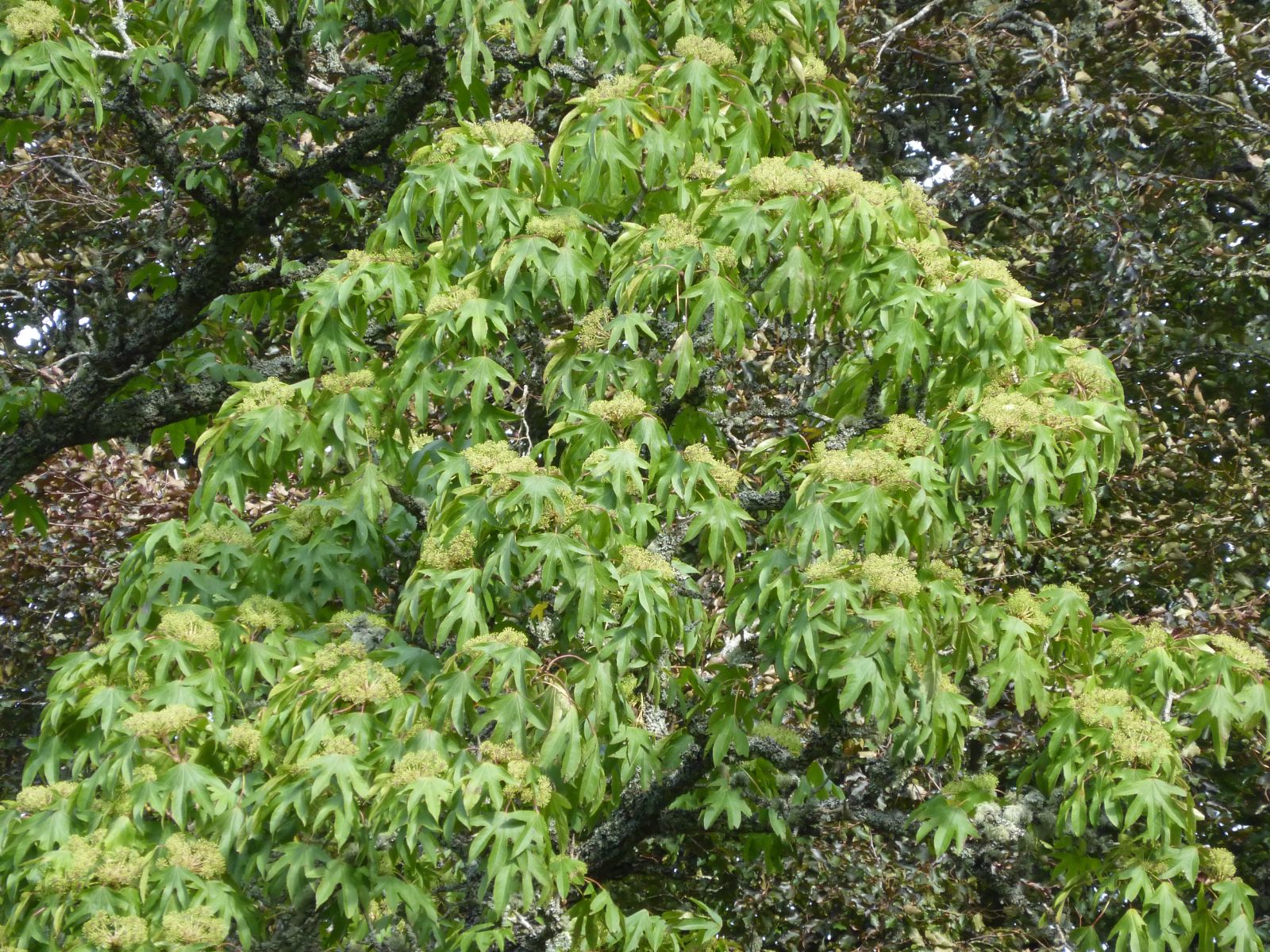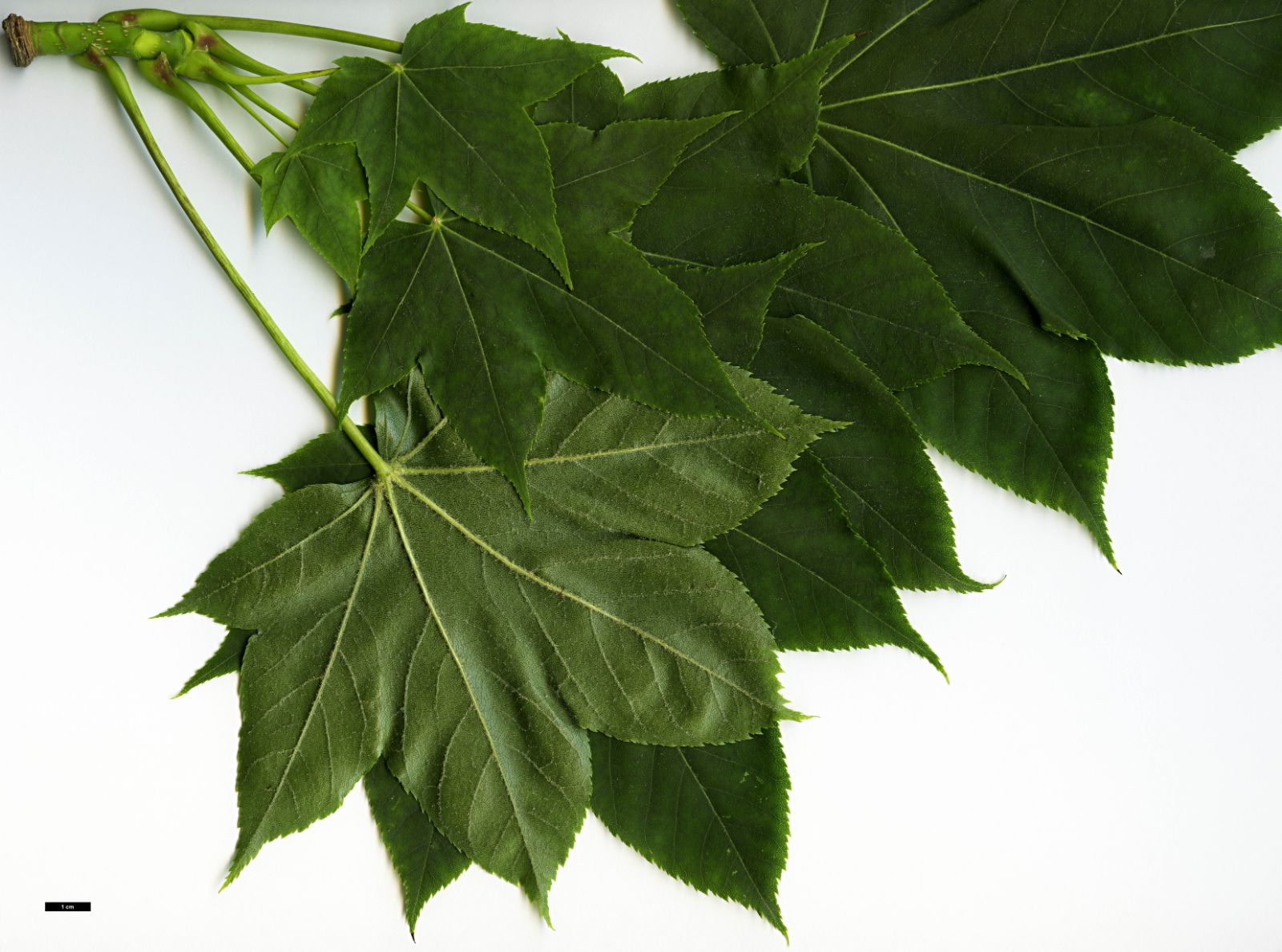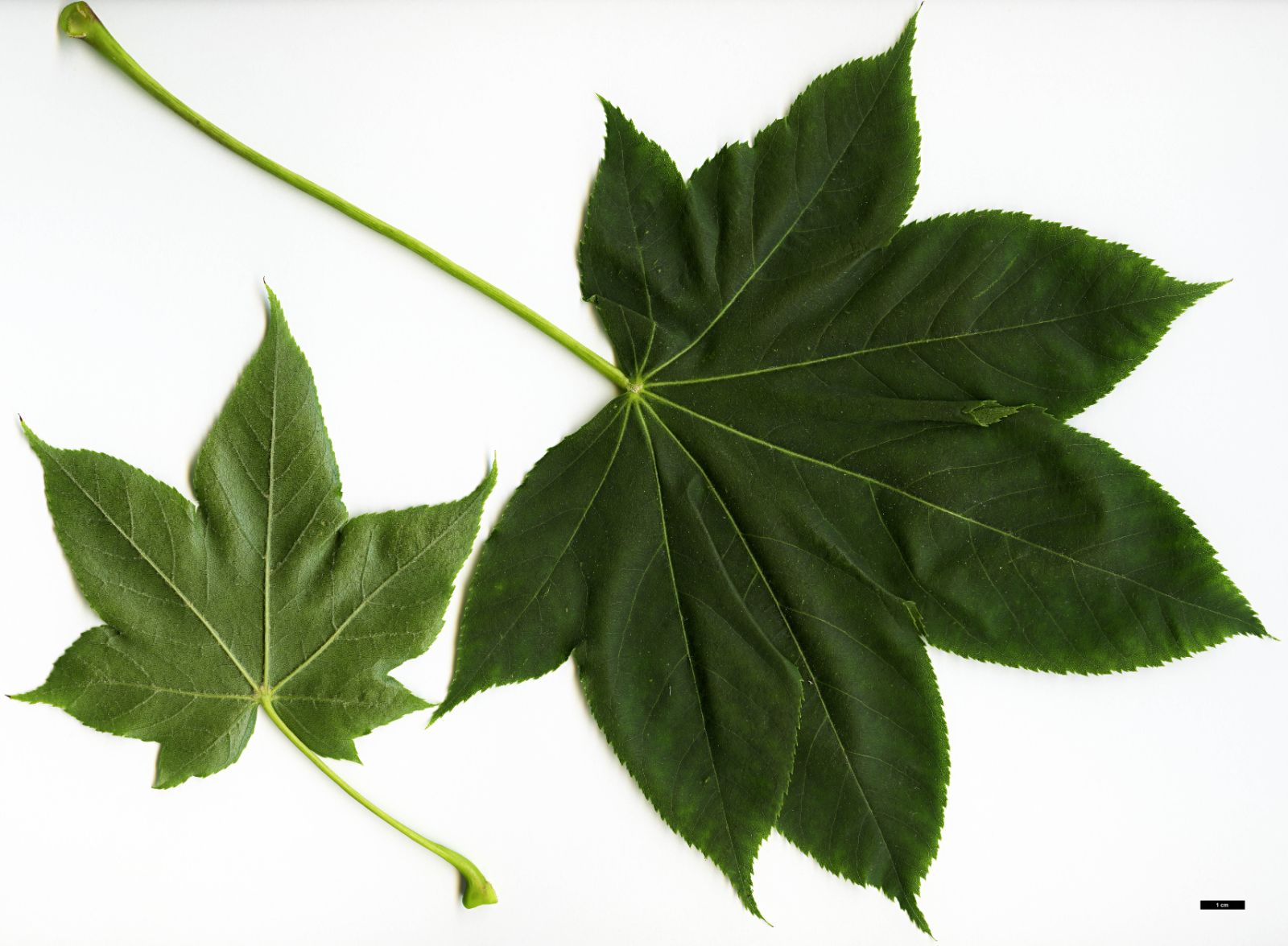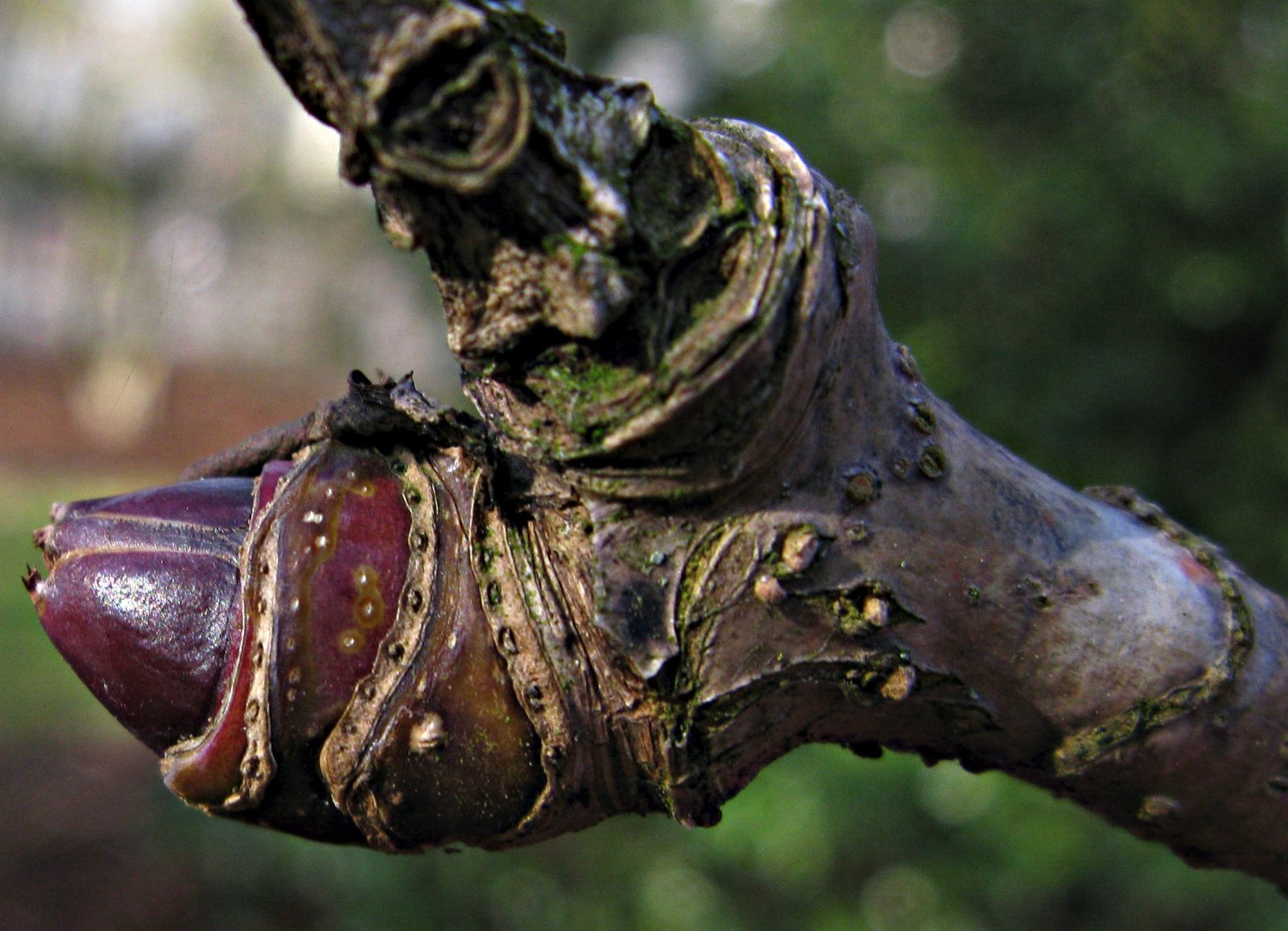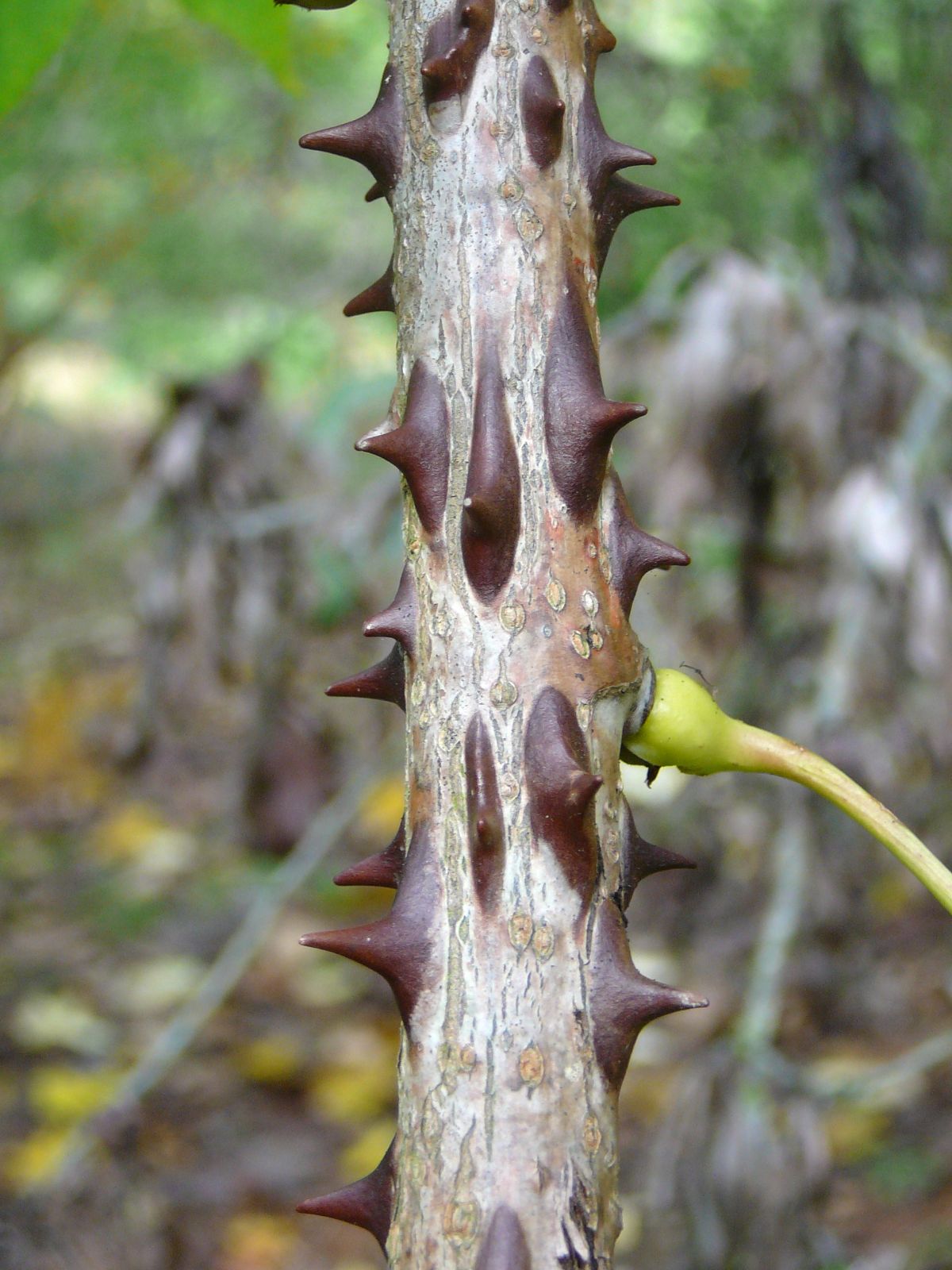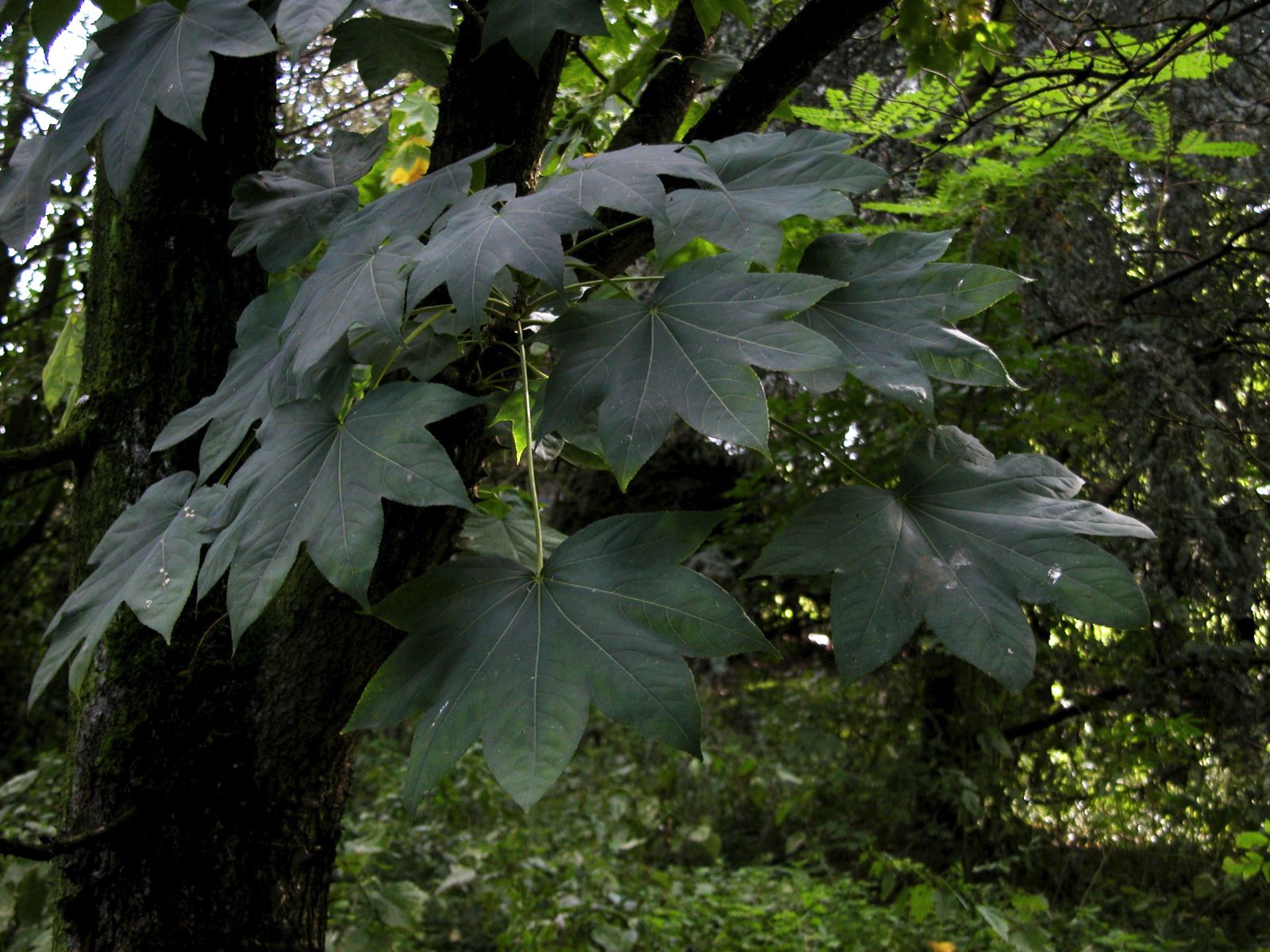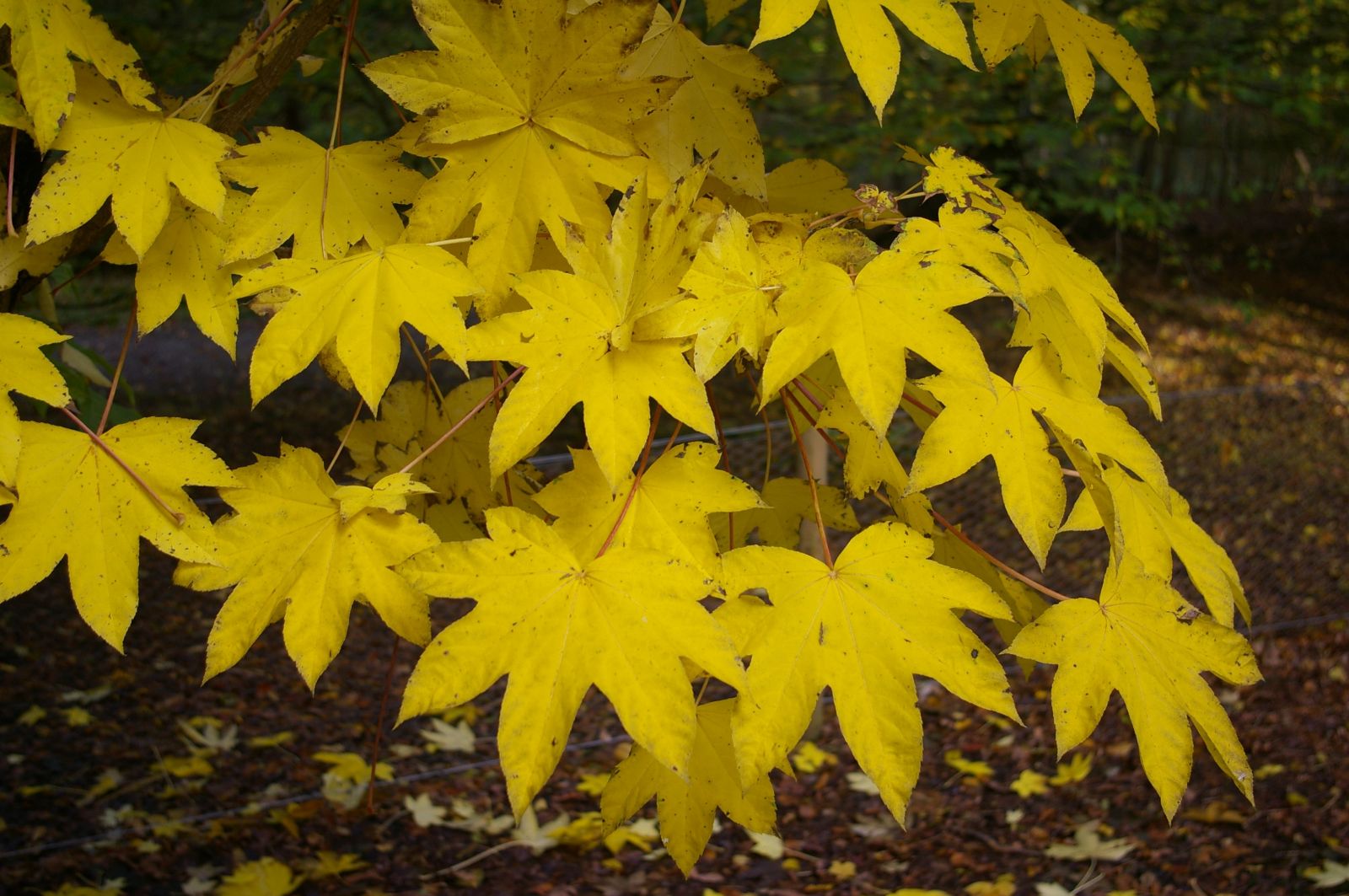Kalopanax septemlobus
Credits
Tom Christian (2023)
Recommended citation
Christian, T. (2023), 'Kalopanax septemlobus' from the website Trees and Shrubs Online (treesandshrubsonline.
Genus
Common Names
- Castor Aralia
- Castor Oil Tree
- Prickly Castor Oil Tree
- Baumaralie
- Stekelboom
- cìqiū (刺楸)
- eumnamu (음나무)
- harigiri (ハリギリ; 針桐)
Synonyms
- Acanthopanax ricinifolium (Sieb. & Zucc.) Seem.
- Acer pictum Thunb.
- Acer septemlobum Thunb.
- Kalopanax pictus (Thunb.) Nakai
- Kalopanax ricinifolius (Sieb. & Zucc.) Miq.
- Panax ricinifolium Sieb. & Zucc.
Tree to 30 m tall, trunk to c. 1.2 m dbh; usually single-stemmed but prone to suckering in disturbed ground. Bark thick, grey to grey-brown, soon developing longitudinal ridges, prominently ridged and furrowed on old trees, occasionally detaching in thick plates. Branches terete, stout, ascending to spreading with numerous stiff broad-based prickles persisting for several years. Leaves simple, alternate, suborbicular, borne on long and short shoots, often clustered crowded near the ends of shoots; lamina 9–25(–35) cm across (largest leaves occur on juvenile trees) usually broader than long, coriaceous, upper surface shining dark green, glabrous, lower surface pale green, glabrous or with whitish tomentum on veins and in axils near base; palmately 5–7-nerved, each nerve terminating in an ovate-triangular to oblong-ovate lobe, apex of lobes acuminate, sinuses varying greatly in depth from shallow notches in margin to deep divisions suggesting digitate leaves; base sub-cordate, margin serrate. Petiole slender, reddish green, 8–50 cm long, glabrous or with scattered whitish tomentum especially near base, united with stipules, sheathed at base. Inflorescence terminal, a many-flowered panicle of umbels 18–25 × 20–30 cm; peduncle 2–6 cm, slender, glabrous; umbels 1–2.5 cm across; pedicels 5–10 mm, glabrous or slightly pubescent, not jointed below ovary. Calyx 5-toothed, teeth short. Petals 5, valvate, white or yellowish green. Stamens 5. Styles 2, 1.5–2 mm, united at base. Ovary 2-carpellate. Fruit a drupe, dark blue to nearly black at maturity, subglobose, 3–5 mm across, with a juicy pericarp. Seeds 2(–3) per fruit, flat, prominently ribbed on one side. Flowering Jul-Aug, fruiting Sep-Oct (China). 2n = 48. (Xiang & Lowry 2007; Bean 1981; Ohwi 1965).
Distribution China Anhui, Fujian, Guangdong, Guangxi, Guizhou, Hebei, Henan, Hubei, Hunan, Jiangsu, Jiangxi, Liaoning, Shaanxi, Shandong, Shanxi, Sichuan, Yunnan, Zhejiang Japan North Korea South Korea Russia Sakhalin and adjacent maritime regions
Habitat A scattered component of primary and secondary forests across a vast range, from sea-level to over 2500 m asl, from warm-temperate forests in southern China and southern Japan characterised by hot humid summers and mild winters and species-rich forests, to parts of northern China and northern Japan and maritime regions of the Russian Far East characterised by short, cool summers and long, cold winters and relatively low levels of species diversity. Usually only abundant following major disturbance.
USDA Hardiness Zone 4-7b
RHS Hardiness Rating H7
Conservation status Least concern (LC)
Taxonomic note Thunberg was the first botanist to describe Castor Aralia, in 1784, but he mistook it for a maple and named it Acer septemlobum. The rules governing botanical nomenclature mean that Thunberg’s is the oldest validly published specific epithet for Castor Aralia and thus has priority. The Araliaceae has always been plagued by taxonomic uncertainty and even its infrageneric classification remains unstable; over the centuries Castor Aralia collected over two dozen synonyms as botanists placed it in genera including Acanthopanax, Brassaiopsis, Panax and Tetrapanax. Miquel published the genus Kalopanax in 1863 and included Castor Aralia in it as K. ricinifolius, based on Siebold & Zuccarini’s name Panax ricinifolius; Japanese botanist Hideo Koidzumi made the combination K. septemlobus in 1925, correctly giving priority to Thunberg’s epithet of 1784, but two years later another Japanese botanist, Takenoshin Nakai, published the name K. pictus, and in a remarkable reversal of Thunberg’s error of 1784 mistakenly applied this name to a specimen of the maple now known as Acer pictum! This left botany with the issue of how to typify A. pictum, a problem which rumbled on through much of the 20th century, during which time this maple became widely known as A. mono while K. pictus became the given name for Castor Aralia. Despite appeals in the 1990s and early 2000s to reject the name Acer pictum (which could arguably have paved the way for the conservation of K. pictus) panels rejected the appeals and conserved A. pictum instead (Crowley 2020), thus clarifying, at last, that the correct name for Castor Aralia is K. septemlobus (Thunb.) Koidz..
Kalopanax septemlobus is a polymorphic yet distinctive tree of the ivy family distributed across a large swathe of east Asia, from hot sticky south-central China to cold harsh Sakhalin. For many years this tree was known as Kalopanax pictus – indeed this name is still frequently encountered – but for some time now K. septemlobus has been the accepted, correct name. The circumstances that prompted this change are improbably complicated (and are implicit in another complex and contentious problem concerning the correct name for Painted Maple, Acer pictum). See ‘taxonomic note’ above.
Within its native range Kalopanax has long been valued for its timber, medicinal properties, and ornamental qualities. A USDA forest service memo dated 1957 records that in Japan sen (the local name for Kalopanax timber) is used ‘in general construction and the manufacture of cabinets, furniture, interior trim, carved items, chests, handles, plywood, musical instruments, boats, and numerous miscellaneous articles. In the United States it is used primarily in the form of plywood for paneling [sic.] and doors’ (Kukachka 1957). More recent interest has focussed on its medicinal properties. It has been widely used in traditional medicine for its anti-diabetic, anti-inflammatory, antinociceptive, anti-rheumatoid and anti-fungal properties (Lee & Kang 2002). It contains a number of triterpenoid saponins, a group of bitter-tasting and usually toxic compounds involved in defending plants against pathogens and herbivores (Lee et al. 2020) and the leaves have been shown to contain high concentrations of compounds with potential application as a natural source of antioxidants (Han et al. 2012).
The first introduction to western cultivation was probably that of the Russian botanist Carl Maximowicz, who introduced seed to St Petersburg from his 1860–1864 visit to Japan. Maximowicz is unlikely to have encountered Kalopanax during his earlier work in the vicinity of the Amur River in Russia’s Far East, where he botanised c. 1854–1856, with much of the area he covered being well beyond the species’ known northern limit at c. 47°N in southern Sakhalin.
From St Petersburg material was soon sent to several other European countries, reaching the Belgian horticulturist Louis van Houtte in 1864 and probably arriving in England at about the same time (Elwes & Henry 1906–1913). Further seed collections soon followed, including from the Baltic German scientist Carl Friedrich Schmidt who collected seed on Sakhalin in September 1866 (Schmidt 1868). The French nurseryman Alphonse Lavallée sent a living plant to the Arnold Arboretum in January 1881 and the Arboretum’s Director Charles Sprague Sargent later collected seed on his first expedition to Japan in 1892 (Port 2014). By the late 19th century nurseries and seed merchants operating out of Japan for the benefit of western markets were regularly offering Kalopanax (Boehmer & Co. 1899).
Accounts of it are rare in 19th century literature, but after seeing it in Sakhalin Schmidt remarked that it was ‘a beautiful tree’ (Schmidt 1868) and the horticulturist Louis Böhmer later called it ‘a handsome tree, especially when in flower, and [it] has almost a tropical appearance’ (Böhmer 1876). Subsequent commentators have made much of this tropical appearance, including Wilson, who included it in his rollcall of Aristocrats of the Garden, observing: ‘The Kalopanax…is one of the noblest trees of the cool temperate regions [… ] The large and handsome palmate leaves give this tree a tropical appearance yet it is perfectly hardy and quick-growing […] As a lawn tree or as a specimen tree by side of water it is unsurpassed’ (Wilson 1917). Donlad Wyman, Head of Horticulture at the Arnold Arboretum, included it in his essay Forty-five of the Best Trees for Massachusetts Gardens but lamented that it remained ‘as yet very rare in American gardens’ (Wyman 1952). Indeed, the Arnold seems to have waged a one-arboretum crusade to popularise this tree in New England in the early to mid-20th century, culminating in 1972 when it was one of ten taxa offered as a ‘reverse birthday present’ to celebrate the arboretum’s centenary (Port 2014).
Yet for all these efforts, Kalopanax has remained stubbornly unpopular, planted only by the relatively few who seek out the unusual. An exasperated Wyman later attempts to understand the disinterest: ‘Still only listed by one nursery (as far as can be determined) this fine tree…has been distributed many times […] The seed takes two years to germinate, one of the reasons why many a plant grower becomes overly impatient and passes it up’ (Wyman 1956). In Europe, too, there is a relative paucity of specimens. Even in the UK and Ireland the Tree Register lists only 45 noteworthy individuals in its public-facing database. It is interesting to compare this tally with that of other ornamental Asian trees: it lists 152 Davidia involucrata; 117 Cercidiphyllum japonicum; 116 Acer davidii; 59 Liriodendron chinense; 52 Trochodendron aralioides; 44 Pseudolarix amabilis; 35 Emmenopterys henryi; 22 Tetracentron sinense and 21 Poliothyrsis sinensis (Tree Register 2022).
The British dendrologist Alan Mitchell seems to have had mixed feelings about Kalopanax. The account in his book Trees of Britain uses such adjectives as ‘strange’, ‘gaunt’, ‘spiky’, ‘eccentric’ and ‘bizarre’ to describe it. It was for this publication that Mitchell coined the common name Prickly Castor Oil Tree, later expressing regret for having done so upon learning that the Americans were already using the ‘more civilised’ moniker Castor Aralia (Mitchell 1996). Regardless, this tree has always been too-seldom grown to warrant extensive league tables of the best and largest in different parts of the world. About 30 m is regularly cited as its climax height in native forests, with a dbh of up to 1 m, rarely more. The largest in cultivation are probably those grown in the UK and Ireland: 20 m × 65 cm dbh in Surrey, England; with others to 18 m tall in locations as disparate as Surrey and Worcestershire in England, Peeblesshire in Scotland, and Kildare in Ireland (Tree Register 2022). In North America the largest are probably those remaining from Sargent’s 1892 gathering in Japan at the Arnold Arboretum – 15.8 m with a canopy spread of over 23 m in 2014 (Port 2014) – although there have been bigger, to 17 m × 67 cm dbh c. 1980 (Jacobson 1996). In Belgium, a tree at Arboretum Tervuren had a dbh of 60 cm in 2020, but its height was not recorded; there are other fine examples at Kalmthout and Herkenrode which frequently produce a few seedlings (Arboretum Wespelaar 2023; pers. obs.).
A brief survey of cultivated trees quickly paints Castor Aralia as a hardy, adaptable, and thoroughly un-fussy tree. Examples in North America and northern Europe, including some very cold areas, quickly banish any question that it is anything other than bone hardy. It is also perfectly tolerant of heat: Philippe de Spoelberch successfully grows Kalopanax at Les Mourgues in the south of France where temperatures regularly reach 40°C and drought conditions are frequent (P. de Spoelberch pers. comm.; pers. obs.) but it remains to be seen whether the trade-off in such conditions is a reduced lifespan. In the UK mature trees may be found in collections on deep, fertile, humous-rich soils such as those at Dawyck Botanic Garden, Peeblesshire, and on shallow soils above solid chalk, such as at Pampisford, Cambridgeshire; it grows as cheerfully in areas with high rainfall as it does in the driest parts of these islands, and young plantings in several rather wet sites are thriving, too (pers. obs).
Nevertheless, in some soil types, Castor Aralia is possibly sensitive to rapid fluctuations in the water table. The tree from Nanjing, accessioned at the Royal Botanic Garden Edinburgh in 1934, had to be deaccessioned in March 2023: three successive spring-summer droughts had taken their toll and in its weakened, stressed state, the tree was rapidly succumbing to Armillaria (W. Hinchliffe pers. comm. 2023).
Castor Aralia is cultivated in Australia where there are multiple specimens in collections throughout the southeast, and where it is seemingly a more precocious flowerer than in the cooler climate of northwest Europe. It is very rare in New Zealand (G. Church pers. comm.).
Propagation by seed is straightforward, but without treatment seed will usually require two winters to germinate. Root cuttings are another easy means of propagation, as is the removal of suckers which mature trees will produce sporadically, and young trees in abundance in response to damage (which has proven a disadvantage in attempts to eradicate young trees from natural areas in the USA). Kalopanax has demonstrated a remarkable ability to recover from major arboricultural interventions: a specimen at Leckmelm, near Ullapool on the NW coast of Scotland, was pollarded in 2013 and has recovered beautifully (pers. obs.).
For all the efforts of their predecessors to popularise Kalopanax in North America, staff at the Arnold Arboretum today are probably quite grateful for their failure. Seedling recruitment has been known for some time but in recent years the species has shown a tendency to invasiveness in various parts of the northeast. A study at the University of New Hampshire found thousands of volunteer plants all probably traceable to a single individual planted in 1972: these levels of recruitment, taken with the species’ extraordinary shade tolerance as a seedling, potentially very rapid growth, and its ability to sucker, especially when damaged, all contribute to significant and legitimate concerns about its continued use as an ornamental, at least in the north-eastern USA (Lee et al. 2017).
A programme of deaccessioning Kalopanax at the Arnold Arboretum commenced in 2010, with seven accessioned individuals removed in the first phase to 2012 (Port 2014). In early 2023 three mature individuals remain at the Arnold, retained for now due to their historic and landscape value: two derived from Sargent’s 1892 collection in Japan (accessions 12453*A and *C); and another traceable to Nanjing Botanical Garden via the US National Arboretum (accession 841–81*A) (M.S. Dosmann pers. com. 2023). Dosmann, Keeper of the Living Collections at the Arnold, sums up his own mixed feelings for this species which will likely resonate with many others who grow or admire it: ‘On the one hand, I’m a big fan. And yet, because it is notable in its ability to wander and take root in natural areas, I’m wary of recommending it for widescale cultivation’ (M. Dosmann pers. comm.).
These North American experiences should sound a warning to those who grow this tree elsewhere, especially in Europe, where some seedling recruitment is regularly observed in Belgium (K. Camelbeke pers. comm.) and in warmer parts of the UK (pers. obs.). Nobody should plant one unless they are prepared to grub it out at a moment’s notice, but in areas where it hasn’t shown a tendency to invasiveness it remains thoroughly worthy of planting.
Maximowiczii Group
Synonyms
Aralia maximowiczii Van Houtte
Kalopanax septemlobus f. maximowiczii (Van Houtte) H.Ohashi
Any form of Kalopanax septemlobus subsp. septemlobus with lobes divided to at least halfway down the lamina of adult leaves (Christian, in prep).
Botanists and horticulturists alike have always acknowledged that Kalopanax is a variable tree, no more so than in its leaves which may have very broad, shallow, acuminate lobes separated by nearly indiscernible sinuses (hereafter referred to as ‘entire’ forms), or elongated lobes with sinuses dividing the lamina nearly to the base (‘divided’ forms). In between these two extremes lies an entire spectrum of variation. Horticulturists in pursuit of the exotic aesthetic tend to favour divided forms: the best of these are certainly extraordinary and could give many Heptapleurum (Schefflera) a run for their money! But this is an unpredictable plant; while divided forms seem to be the norm in contemporary commerce, ordered blind from a nursery there is no predicting what will turn up.
Both entire and divided forms were included in Maximowicz’s original introduction from Japan. The Belgian horticulturalist Van Houtte raised a single plant of the divided form from the seed packet sent from St Petersburg in 1864 and considered it so remarkably different from other seedlings he named it Aralia maximowiczii in 1874 (IPNI 2023). Some permutation of the name maximowczii has been used by horticulturists ever since to distinguish divided-leaf forms from entire ones, but, as is so often the case, contemporary research has pulled the rug of legitimacy from under this concept by demonstrating that none of the macromorphological variations that are of such interest to horticulture warrant any sort of taxonomic distinction.
Chang et al. (2003) investigated 20 morphological characters across 126 specimens representing the full geographic range of Kalopanax and concluded ‘No clear distinction could be found between material assigned to the previously recognized var. maximowiczii, and to var. septemlobus, and forms intermediate in leaf morphology between these two taxa suggested that they should be united […] The results of this study indicate a continuum in leaf morphology among the previously recognized infraspecific taxa. This continuum is especially evident in leaf lobing and pubescence, characters traditionally used to define infraspecific taxa’.
These findings agree, more or less, with Ohwi’s treatment of the genus in his Flora of Japan (Ohwi 1965) which recognised only var. lutchuensis, a glabrous form restricted to the Ryukyu Islands of southernmost Japan. Ohashi later clarified various aspects of nomenclature and revised the infraspecific taxa at the same time, following Ohwi in recognising only var. lutchuensis but elevating it to the rank of subspecies to give us the taxonomy now followed by several major reference works, including Plants of the World Online (Plants of the World Online 2023; see below).
Unfortunately, redundancy of the name maximowiczii is unlikely to go down well with anybody who grows or sells plants previously placed here, such is their distinctiveness compared with entire-leaf forms, but Chang et al. (2003) are emphatic in their rejection of any taxonomic recognition, including at the rank of forma, which is how these plants are most often sold (indeed, to many horticulturists this is a perfectly reasonable approach). However, an alternative approach, adopted here, is to treat these as a Cultivar Group, which provides growers with a legitimate alternative whilst satisfying botanical purists, but it would be preferable to select the best divided forms and give them formal cultivar names and perpetuate these clones in gardens via vegetative propagation.
subsp. lutchuensis (Nakai) H.Ohashi
Plants glabrous in all parts; restricted to the Ryukyu Islands of southern Japan (Ohwi 1965).
Distribution
- Japan – Ryukyu Islands
This subspecies differs only in being glabrous in all parts; it is recognised in part because this point of morphological distinction correlates with a discrete distribution in Japan’s southern Ryukyu Islands. No introductions from this provenance have been traced growing in our area.

